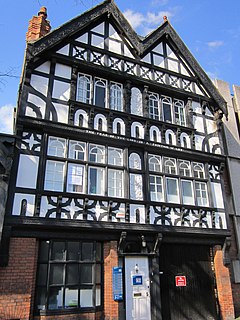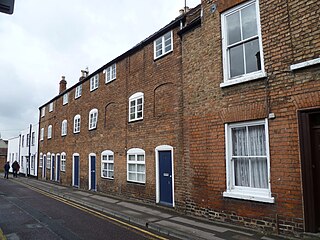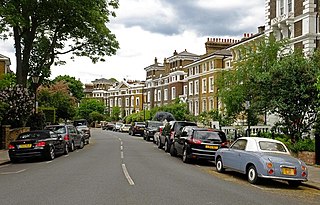
Queen's Gate is a street in South Kensington, London, England. It runs south from Kensington Gardens' Queen's Gate to Old Brompton Road, intersecting Cromwell Road.
There are 212 Grade II* listed buildings in Bristol, England.

The New Inn, 16 Northgate Street, Gloucester, England, is a timber framed building used as a public house, hotel and restaurant. It is the most complete surviving example of a medieval courtyard inn with galleries in Britain, and is a Grade I listed building. The announcement of Lady Jane Grey's succession to the English throne was made from the Inn gallery in 1553.

Chester is a city in Cheshire, England containing over 650 structures that are designated as listed buildings by English Heritage and included in the National Heritage List for England. Of these, over 500 are listed at Grade II, the lowest of the three gradings given to listed buildings and applied to "buildings of national importance and special interest". This list contains the Grade II listed buildings in the central unparished area of the city within Chester city walls or located adjacent to them.

Gloucester Court of Probate is a grade II listed building at 3–4 Pitt Street, Gloucester in England.

The Fountain Inn is a grade II listed public house at 53 Westgate Street, Gloucester, England. It is mentioned in an Abbey Rental document of 1455. Some of the building is from the late 16th century but it was mostly rebuilt in the late 17th century, altered in the 18th century, and remodelled around 1900.

Bearland House is a grade II* listed building in Longsmith Street, Gloucester, England.
Bridgnorth is a civil parish in Shropshire, England. It contains 252 listed buildings that are recorded in the National Heritage List for England. Of these, one is listed at Grade I, the highest of the three grades, twelve are at Grade II*, the middle grade, and the others are at Grade II, the lowest grade. The parish contains the town of Bridgnorth and the small villages of Quatford, Danesford, and Oldbury. The River Severn passes through the town, and divides it into two parts. The part on the western side is mainly hilly, and is known as High Town, and the part by the river and on its east side is much flatter, and is known as Low Town. The two parts are joined by a bridge over the river.

Orsett Terrace, originally known as Orsett Place, is a street in the Westbourne district of the City of Westminster, in London. It runs roughly east–west between Porchester Terrace in the west and the junction of Westbourne Bridge and Westbourne Terrace in the east. It is crossed midway by Gloucester Terrace.

Northgate House is a grade II* listed building at 19 London Road in the city of Gloucester, England. It was built in the mid to late 17th-century and refronted in the mid 18th-century.

High Orchard was an industrial area of the city of Gloucester in England that was developed in the 19th century on the former orchard of the Priory of Llanthony Secunda (1136). The area was closely associated with Gloucester Docks immediately to the north, and served by the Gloucester and Sharpness Canal and railway transport. It was the site of Fielding & Platt's Atlas Works and a number of other significant local employers.

Bristol Road in the City of Gloucester dates from the medieval period. It runs between Southgate Street in the north and Quedgeley in the south where it joins the Bath Road and the A38. It contains a number of listed buildings and other notable structures.

Pitt Street in the City of Gloucester runs between the junction of Priory Road, Archdeacon Street, and St Mary's Street in the north and the junction of Hare Lane and Park Street in the south.

Barton Street is a street in the Barton and Tredworth district of Gloucester that is the location of a number of listed buildings:

Southgate Street is one of the ancient streets in the City of Gloucester, so named because its southern end was originally the location of the south gate in the city's walls. The part beyond the gate as far as Severn Street was sometimes known as Lower Southgate Street. It runs from the crossroads of Northgate, Eastgate, Southgate, and Westgate Streets in the north to Bristol Road in the south.

Commercial Road is located in the City of Gloucester, England. It runs from The Quay and Severn Road in the north to Kimbrose Way and Southgate Street in the south. It is joined by Barbican Road and Ladybellegate Street on the north side and by entrances to Gloucester Docks on the south side.

Northgate Street is a street in the City of Gloucester, so named because its northern end was originally the location of the north gate in the city's walls.

George Worrall Counsel was a Gloucester solicitor, antiquarian, alderman, and property developer.

Oxford Street is located in the City of Gloucester, England. It runs between London Road in the south and Oxford Road in the north. It was developed as uniform stuccoed terraces by the attorney John Bowyer on a plot that he had bought in 1823.

Gloucester Crescent is an 1840s Victorian residential crescent in Camden Town in London which from the early 1960s gained a bohemian reputation as “the trendiest street in London” and "Britain's cleverest street" when it became home for many British writers, artists and intellectuals including Jonathan Miller, Alan Bennett and Alice Thomas Ellis.



















